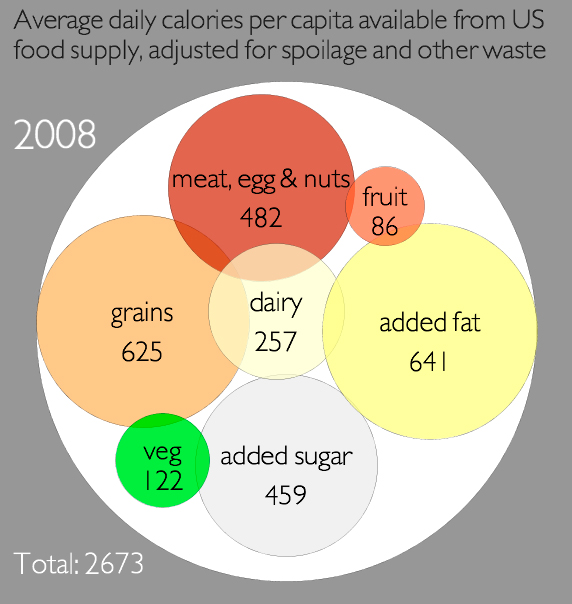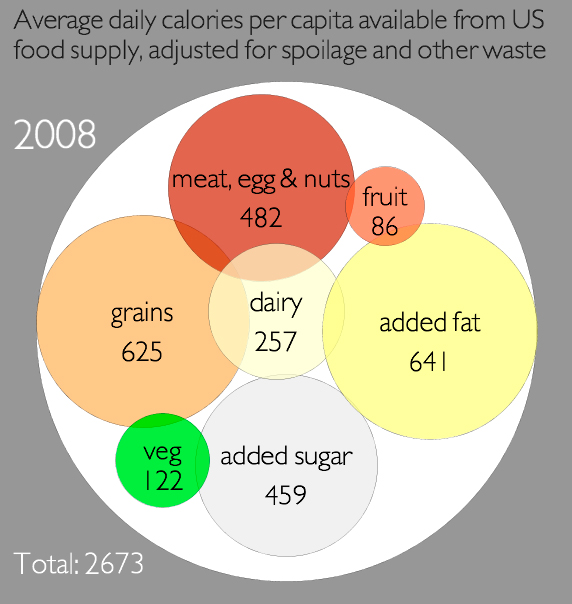 This is a non-interactive version of the chart. Also check out the interactive version, by Civil Eats and the UC-Berkeley Graduate School of Journalism News21 course.Over on Civil Eats, Andrea Jezovit has put together a terrific interactive chart on the U.S. diet. Using USDA data for “average daily calories available per capita, adjusted for spoilage and waste,” it tracks our eating habits since 1970, separating our foodstuffs into basic categories: grains, dairy, vegetables, fruits, proteins (“meat, eggs, and nuts”), added sugars, and added fats.
This is a non-interactive version of the chart. Also check out the interactive version, by Civil Eats and the UC-Berkeley Graduate School of Journalism News21 course.Over on Civil Eats, Andrea Jezovit has put together a terrific interactive chart on the U.S. diet. Using USDA data for “average daily calories available per capita, adjusted for spoilage and waste,” it tracks our eating habits since 1970, separating our foodstuffs into basic categories: grains, dairy, vegetables, fruits, proteins (“meat, eggs, and nuts”), added sugars, and added fats.
For me, the most interesting categories are the latter two. They represent what could be called the “value added” by the food-processing industry. The other categories mainly represent whole foods; the added fats and sugars are what the food industry uses to tart up whole foods to make them more appealing in marketing to consumers. (The one exception to that description is soda, which is essentially pure “added sugars” without any whole foods, suspended in a water medium along with a few synthetic flavoring agents and dyes. It is bizarre how much chemical-laced sugar water we consume.)
At any rate, I decided to crunch a few numbers from Jezovit’s great chart to shine a light on the centrality of added fats and sugars to our diets. In 1970, the U.S. food system churned out 2,168 calories per day per person, of which 402 came from added sugar and 410 from added fat. Combined, that’s 812 calories from additives, or about 37 percent of the total.
Jump forward to 2008 (the last year for which there are figures), and you find that the food system cranked out 2,673 calories per person. That’s an impressive 23 percent jump from the 1970 number — even more impressive when you recall that it’s a per capita number and U.S. population rose significantly over that period. This is powerful evidence that the cheap-food policy instituted by Nixon-era USDA chief Earl Butz succeeded dramatically. In an age of maximum production of corn and soy, the U.S. food system became a calorie-generating juggernaut.
As for added fats and sugars, their 2008 levels reached 459 and 641, respectively, for a total of 1,100 calories. That’s a 35 percent jump over the 1970 level — and represents 41 percent of total calories available to U.S. consumers in 2008.
So, what is all this telling us? Here’s a simple conclusion: If the food processing industry simply cut added sugars and fats by half in calorie terms — from 1,100 calories to 550 — total caloric availability would return to 1970 levels: an era that preceded the recent surge in diet-related maladies like obesity and Type 2 diabetes.
We can also read the chart for information on how the bounty of corn and soy unleashed since 1970 has been used. Corn and soy are the principal feeds for confined animals, so we might expect to see a jump in meat and egg calories. Yet the chart tells us that the food system generated 463 calories from “meat, eggs, and nuts” in 1970 and and 482 calories from those foodstuff in 2008. That’s just a 4 percent increase. So the corn/soy boom didn’t translate into a meat boom — it made meat significantly cheaper as feed costs fell, but it didn’t inspire people to eat much more of it. Don’t get me wrong: Americans put away a huge amount of meat, more than nearly any other country per capita. It’s just that our meat consumption hasn’t changed much since 1970. (There was, however, a massive shift in the diet from beef to factory-farmed chicken, as this recent New York Times chart shows.)
Where all that cheap corn and soy really seems to have gone is into added fats and sugars. Corn, of course, gets turned into high-fructose corn syrup, use of which skyrocketed throughout the 1980s and remains quite high. Indeed, Americans on average get 10 percent of their overall calories from this one invisible yet ubiquitous product, which graces everything from soda to ketchup. And soy gets turned into lots and lots of soybean oil — much of it partially hydrogenated — which then gets put into everything from baked goods to peanut butter to potato chips.
I think it’s fair to say that a massive part of our diet-related health problems stem from sugar isolated from corn and fat isolated from soy.
All of this made me think of this excellent recent New York Times Magazine article by Annia Ciezadlo on the paradoxes of what has become known as the “Mediterranean diet,” known for its reliance on fruits and vegetables, whole grains, olive oil, and small amounts of meat, fish, and eggs. As the wonderful cookbook writer and historian Clifford Wright notes in his (ironically titled) book A Mediterranean Feast, the diet grows out of scarcity and resourcefulness.
“Consider that until recently the picture of the Mediterranean was one of poverty and destitution, even in the richest countries,” Wright writes. “Mediterranean cuisines developed as a reaction against the monotonous foods of centuries of famine and starvation.” People generally relied on what the land around them could grow; weeds, as Patience Grey shows in her classic book Honey from a Weed: Fasting and Feasting in Tuscany, Catalonia, the Cyclades and Apulia, provided a key source of nutrients. There was no food industry cranking out sugars and fats to add to food; they were precious ingredients, and used sparingly. In her NYT piece, Ciezadlo shows that such traditions are eroding all around the Mediterranean as the popularity of U.S.-style fast and convenience food — laden with plenty of added sugars and fats — explodes. And as the traditions wane, diet-related health troubles in Mediterranean nations are surging to U.S. levels. Today, she writes, “Mediterranean people have some of the worst diets in Europe, and the Greeks are the fattest: about 75 percent of the Greek population is overweight.”
It’s interesting to me that here in the United States, the diet promoted by the sustainable food movement is largely patterned on the old Mediterranean style. People generally have to pay a premium to attain it, and a wealth of science shows it to be quite healthy. (Note that a diet similarly stripped of added fats and sugars seems to help prevent ADHD in children.) The diet championed by the food industry and its marketers is cheaper, but a wealth of evidence suggests it makes people sick and miserable.



